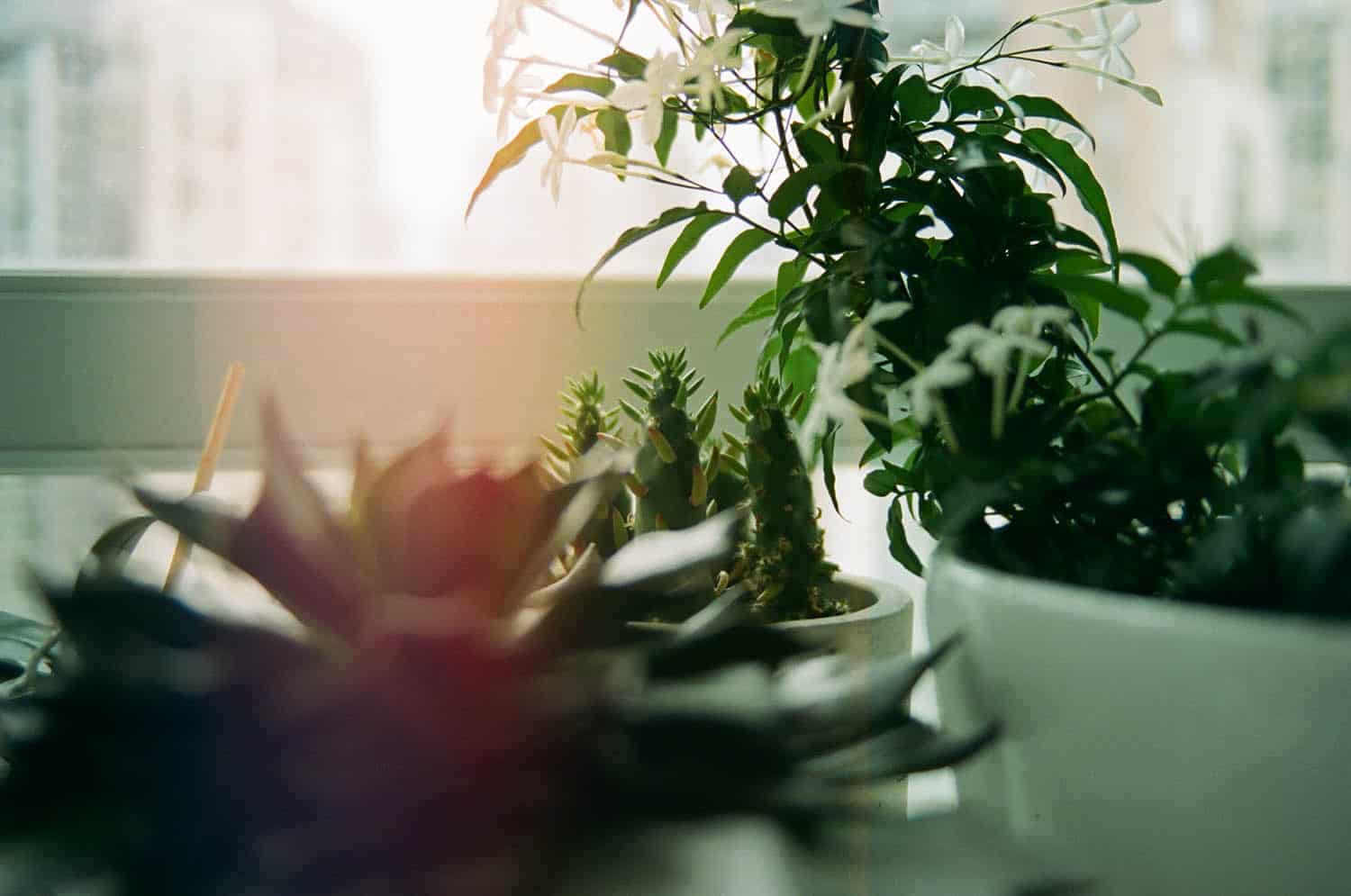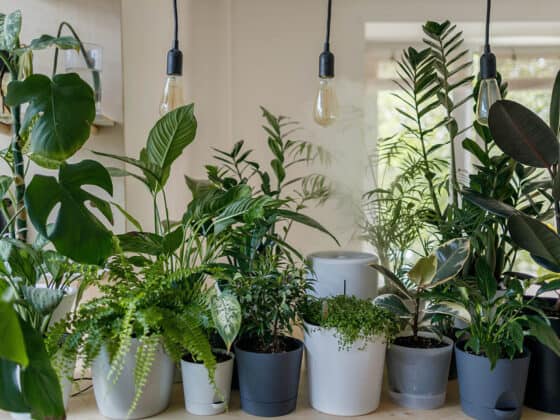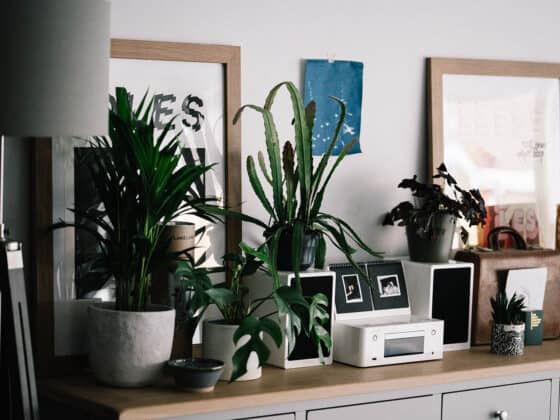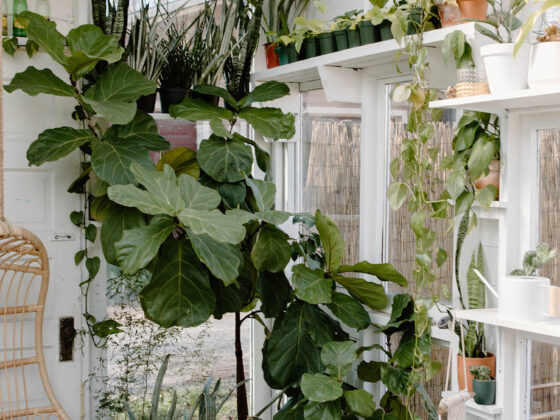Houseplants bring beauty and freshness into our homes, but they can also attract unwanted guests. One of the weirder looking pests you may find on your plants is mealybugs. These tiny, cottony insects feed on plant sap and can wreak havoc if left untreated. Catching an infestation early is helpful, but how do you identify them? And, more importantly, how do you get rid of them?
Mealybugs are small, sap-sucking insects that are most commonly identified by a fluffy, cotton-like material that covers their bodies and are often found hidden amongst stem tips, leave junctions, and within new growth. Like many other pests, plenty of treatment options are available to get rid of them.
Mealybugs can be persistent pests, mainly due to their ability to hide away in dense foliage where they avoid contact with sprays or pesticides. Catching an infestation early will make treatment options that much more effective.
In this article, we will explore what mealybugs are, how they spread, and most importantly, the best treatment options available to combat these tenacious pests effectively. By the end, you’ll be armed with the knowledge and strategies needed to restore your houseplants to their former health and vibrancy.
What Do Mealybugs Look Like?
In general, mealybugs are easy to identify due to their unique looks. Although there are several different species, most can be described as pink, soft-bodied insects that are covered in a white, cotton-like material.
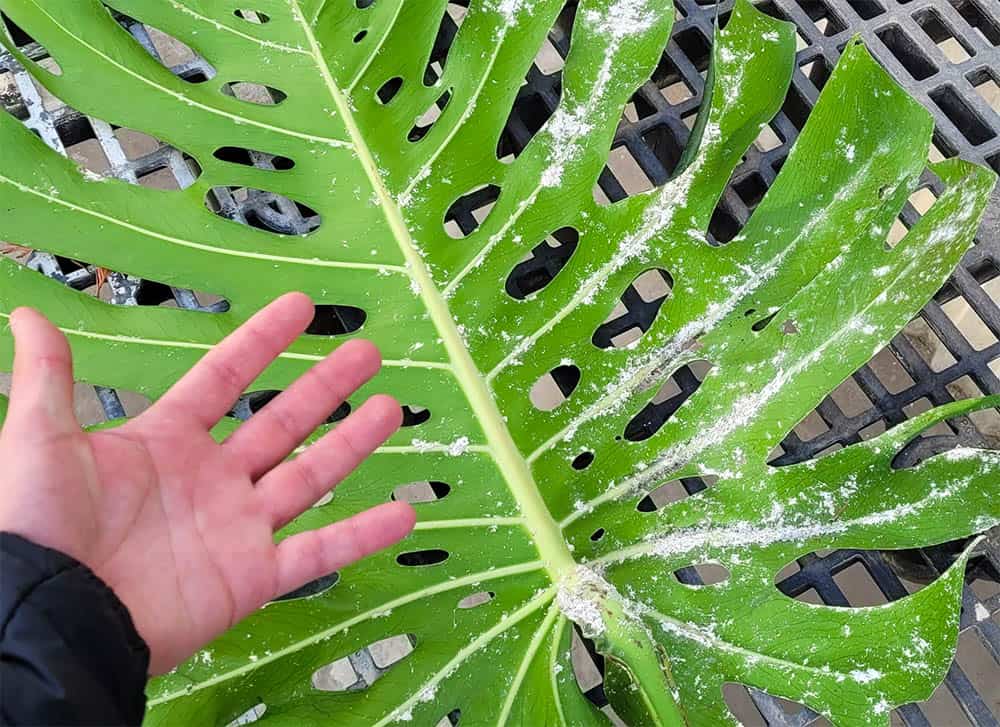
This cotton “fluff” is actually a waxy, filament-like coating that serves several different functions including camouflage, protection from excess heat and moisture loss, and protection from predators. Depending on the species, this fluff can actually appear more dusty or powdery.
Adult mealybugs are only about 1/16 of an inch long but sometimes appear much larger due to their waxy coatings. Females have more rounded bodies and tend to be larger than males.
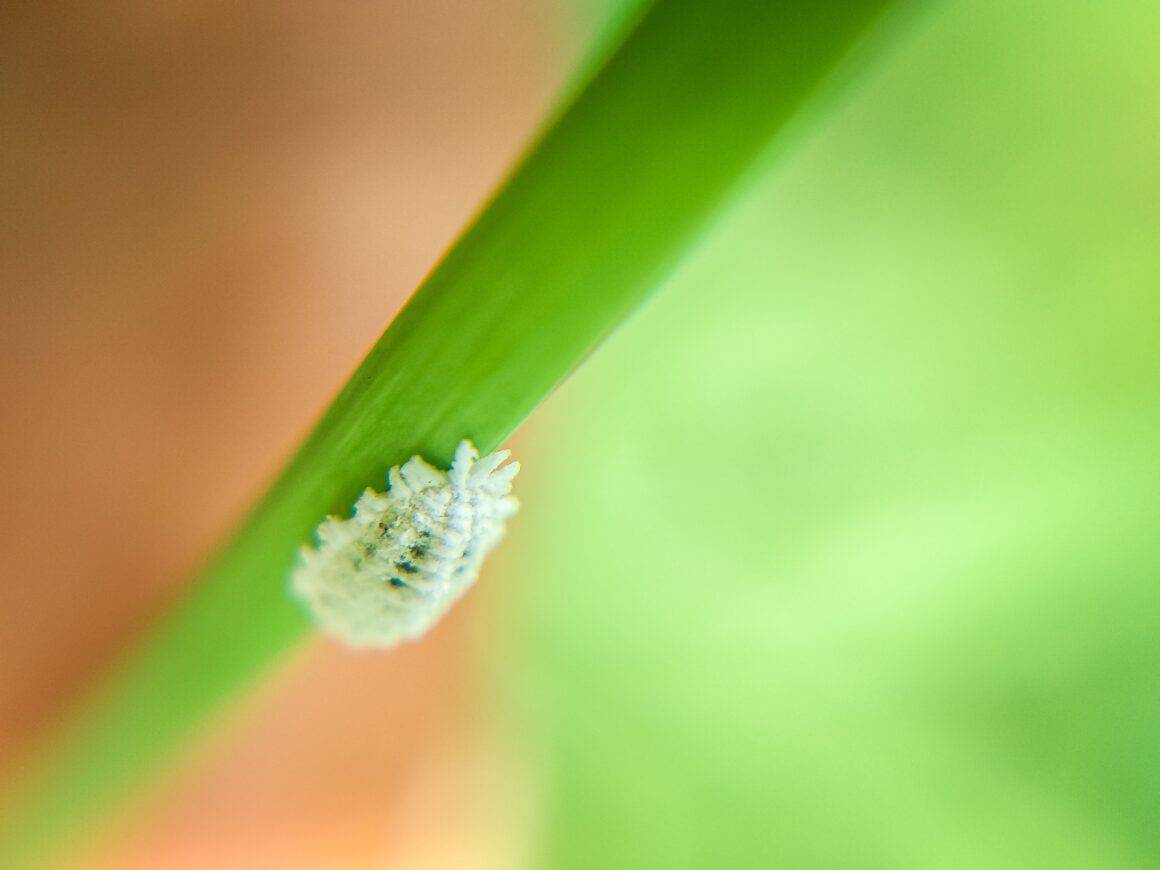
Of all the different species, citrus mealybugs are the most common type to be found on houseplant foliage. Several kinds vary in different ways, but they are much less common indoors.
How Do Mealybugs Reproduce and Spread?
The lifecycle of the mealybugs isn’t as fast as some other very common houseplant pests, but a full-blown infestation can still happen over the course of a few weeks. In many species, including the citrus mealybug, the entire lifecycle tends to happen on the plant foliage, which is good to know when considering different treatment options.
Adult females kick off the cycle by laying eggs. These eggs are covered in the same waxy filaments that cover the mealybug’s body as an added layer of protection. Over the course of five to ten days, a female can lay up to 600 eggs and then usually die afterward.
Alternatively, some species of mealybugs actually birth live young, similar to how aphids reproduce. These young nymphs go through several juvenile stages before they molt into sexually mature adults.
Male mealybugs only have one job: finding a female to mate with. Their small, gnat-like bodies develop wings to help them move around, but the added mobility is only used to help find a mate rather than to feed on another plant. They also usually die after mating.
Although mealybugs tend to stick close to home, they can and will spread to other houseplants fairly easily through several common methods.
First, because of their small size and bodily makeup, they can get easily attached to our clothing or even our pets’ furry coats. If we brush up against a plant with mealybugs present, our gardening glove or sleeve might pick up and transport a few individuals, which is enough to start a new population.
Alternatively, new plants introduced to our homes might be harboring some stowaway mealybugs that, despite their small size, are still fairly mobile on their little legs. If we set new houseplants in close proximity to others, there is a chance that mealybugs will spread, especially if the foliage of plants overlap anywhere. This is why isolating any new plants you bring into your home for at least a few days is always a good idea. After you’ve had a chance to inspect the plant for pests or diseases, and there are no signs of distress, you can incorporate it into your greater collection.
Signs That Your Houseplant Has Mealybugs
Even though mealybugs tend to be smaller in size, they are still fairly easy to detect due to their cotton ball-like appearance. There’s nothing quite like them, so if you start seeing small white patches on the leaves, stems, or flowering parts of your houseplant, take a closer look.
Periodic visual inspection of your houseplants is the best preventative measure you can take against mealybugs. Both the bugs themselves and the egg clusters will look like little puffs of cotton. If caught early enough, treatment plans are usually pretty straightforward and can knock back a small infestation quickly.
However, sometimes we miss the obvious signs. I can walk by a plant 20 times without really looking at it, only to notice weeks later that something is wrong. It happens. If mealybugs have gotten a foothold on one of your houseplants already, you might see a few signs of distress before you even realize you have a pest issue.
Mealybugs, like aphids, are sap-sucking insects that pierce through plant tissue to get access to the phloem. They tend to congregate near stem tips, leaf junctions, and new, tender growth for easiest access to the sap. As they feed, their mouthparts create damage, which starts to add up as the population grows.
You might start seeing yellowing or chlorotic leaves on your plant. In more severe cases, leaves will fall off completely, and the entire plant can begin to droop or wilt. Citrus mealybugs even have a toxin that gets injected into the plant when they feed, which causes plant deformities on new growth.
Lastly, you may start to see a sticky, shiny substance covering the leaves and stems of your houseplant. This is honeydew, a substance excreted by the mealybugs that creates a sticky film over plant surfaces and tends to encourage the spread of sooty mold.
Some species of mealybugs are actually root-feeders. They are not as common on indoor houseplants but are attracted to certain types of plants, like African violets. Ground mealybugs feed on the fine root hairs in the dirt, which act as the capillary system for a plant’s root system. Sustained damage to these root hairs can cause yellowing leaves, wilting, stunted growth, and bloom reduction.
If you suspect you are dealing with a ground mealybug infestation and your plant is showing signs that support your suspicions, you can try to confirm their presence by looking for cottony masses around or near the drainage holes of the pot. However, in most cases, you’ll likely have to remove the plant from the pot and inspect the root ball for mealybugs.
How to Treat Houseplants for Mealybugs
Once you identify a mealybug infestation on one of your houseplants, working quickly is a good idea. Because these insects can be difficult to get rid of, treating your plant when the infestation is lighter can be really effective. More established populations will often require more extreme treatment methods or several applications to ensure good coverage.
The good news is that you do have several different methods to deal with mealybugs. More often than not, you’ll likely be dealing with citrus mealybugs (or a similar species), so you can focus on treatments that are applied to the leaves and stems. If you suspect you are dealing with ground mealybugs, you’ll also want to deploy some kind of drench to kill any bugs feeding on the root system.
First Steps for Mealybug Treatment
Before you do anything else, you will definitely want to isolate your infested houseplant away from the rest of your collection. Because mealybugs can travel, you want to make sure you don’t inadvertently spread them to other plants in your home. One infestation is enough to deal with!
You can also effectively knock back the population of mealybugs on your plant by dislodging them under a strong stream of water. Use a garden or sink hose to spray down your plant, focusing on the stems, underside of leaves, and any other place you see mealybugs present.
This is a great first step, but you should know that water alone won’t remove every mealybug from the plant. You will still need to follow up with a treatment method to ensure you get full coverage of the entire population. Also, if your houseplant is delicate or won’t otherwise stand up to a strong spray of water, skip this step. You don’t want to inflict any more damage above and beyond what the mealybugs are already doing.
You can also wipe your plant down with a cloth to physically dislodge the mealybugs from where they are congregating. Again, this will greatly reduce numbers initially, but it likely won’t get all of them. Once you’ve worked to physically remove what you can, you can decide which treatment option below will work best for you and your household.
Soapy water
An easy, low-impact treatment option you can deploy is to spray your plant with soapy water. Like many soft-bodied insects, mealybugs do not do well when exposed to soap, as it dissolves their waxy protective coating and exoskeletons, causing them to desiccate and die.
This method is as easy as adding about a teaspoon of dish soap to a spray bottle of water. Coverage is key, so spray your entire plant, working especially hard to cover the underside of leaves and within dense foliage. You’ll likely want to repeat these applications every few days to catch any mealybugs that might have eluded the soapy water previous times.
Rubbing alcohol
Much like soapy water, diluted rubbing alcohol can be an effective treatment that breaks down the waxy protective coatings of mealybugs.
In previous pest articles, I’ve discussed using highly diluted rubbing alcohol mixtures as a foliar spray. This protects the plant from burns caused by concentrations that are too high. You can definitely start with this method, but because of mealybugs’ waxy fluff, you might need to mix slightly stronger mixtures for subsequent applications.
Start with 1 part 70% isopropyl alcohol to 20 parts water, and work up from there.
Alternatively, spot treating your plant with a cotton ball or Q-Tip dipped in straight 70% isopropyl alcohol has been known to be a very effective treatment for mealybugs. The difference here is that you are using a stronger solution to treat very specific spots on the plant, mainly where mealybugs are.
The alcohol will dissolve their cuticles and usually kill them on contact. It is important that if you go with this spot treatment method, you test your plant first to see if it can handle that strength. A plant usually takes about two days to exhibit any damage caused by rubbing alcohol applications.
Again, coverage is important, so it’s best to be methodical in your applications and repeat every few days until you no longer see any signs of mealybugs on your plant.
Insecticidal soaps
If soap or alcohol aren’t cutting it, another rather low-impact solution is the application of insecticidal soaps. They work in a similar fashion and end up disrupting cell membrane function as the pest’s cuticle dissolves, causing dehydration and death.
Insecticidal soaps are typically a mixture of potassium salts of fatty acids and water mixed as a ready to use formula. All brands are slightly different, but even the most basic insecticidal soap can work well on mealybugs. Even though they are relatively benign products, it’s always a good idea to check the label to ensure the soap you plan to use is indicated for your houseplant variety.
Neem oil (and other horticultural oils)
If you’d like to use a natural product in your home that still has great efficacy against mealybugs, Neem oil is a great choice. Neem is a naturally derived product that completely coats mealybugs, including their mouthparts and vascular systems, leading to suffocation and death. There are many ready to use mixtures that include Neem oil as the primary treatment compound, but you can also buy it as a concentrate and make your own mixtures, depending on your situation.
A Neem oil spray should be applied every five to seven days with good coverage to kill off any mealybugs that have hatched or come out of hiding since the last application. Repeat as necessary until you no longer see any signs of an infestation.
Horticultural oils work the same way as Neem, with the only difference being where the oil was derived from.
Diatomaceous earth
Another really nice treatment option to have in your arsenal is diatomaceous earth. DE is made from the tiny exoskeletons of aquatic algae. It comes as a fine powder that, although mostly harmless to human skin, is very jagged and sharp on a microscopic level and shreds the tissue of soft-bodied insects, causing death.
Although pretty effective against mealybugs, the downside is that DE is most efficient as a dry powder, meaning you either have to shake it over a plant to cover or apply it using a fine paintbrush or something similar.
Even though the application can be a bit tedious, it works well at readily destroying mealybugs’ cottony cuticle and their eggs. If you have the patience to do so, applying diatomaceous earth with a paintbrush is a great way to get into all the hard-to-reach places, like branched stems, leave whorls, or tightly furled new growth.
Chemical sprays
If you caught your mealybug infestation at a later stage and they’ve really gotten a foothold on your houseplant, you may need to work with something a little stronger to knock them back. Many chemical sprays can give you that extra firepower while still being relatively low-impact, depending on which one you go with.
If you opt for a chemical spray, choose one that contains pyrethrins. These plant-derived pesticides tend to be safer than other classes of insecticides and work relatively well. You should still read the label carefully to ensure whatever formula you use is indicated for your houseplant.
A quick note regarding systemic insecticide drenches
There are a lot of resources that suggest specific systemic insecticide products that work as a long-lasting control for heavy mealybug infestations. While this is true, many of the recommended products contain imidacloprid, which is a neonicotinoid, a very strong class of insecticides.
These types of chemicals can be very effective in treating pests, but they will also kill any other beneficial insects that come into contact with the plant. Indoors, this can be considered a nuclear option that can be dangerous to humans or pets. Make sure you understand how to use these products if you choose this option.
Pruning or removal
If your mealybug infestation has gotten the better of you, and you don’t seem to be making any progress, you may want to consider more extreme options like removing some or all of your plant. If you notice that certain parts of your houseplant are harboring a majority of a mealybug population, you might be able to gain better control of the situation by pruning them back in an effort to save the rest of the plant.
Remove any pruned plant matter from your home immediately, preferably wrapped in a garbage bag. Whatever remains of your houseplant should continue to be treated for the remaining infestation.
And, of course, if, despite your best efforts, you’ve lost the war to the mealybugs, do not hesitate to throw the whole thing out. If your plant has sustained severe damage from the infestation, remember that it might never fully recover, and ditching it might be the best use of your time. Sometimes it is better to cut our losses and start over with a new plant.
Final Thoughts
Mealybugs are strange and persistent insects that can do a lot of damage over the course of several weeks. It might take a while to start seeing signs of distress on your plant, but by then, you better believe these pests have established a good-sized population. However, now that you know what to look for, early detection of these unique pests is possible, giving you the best opportunity to eradicate them before they significantly affect your houseplant.
Treatment is all about good coverage. Make sure that, regardless of the method you deploy, you are really getting into all the nooks and crannies of your plant to ensure no mealybug goes undetected. With a little persistence on your part, your houseplants will be pest free and happy!






